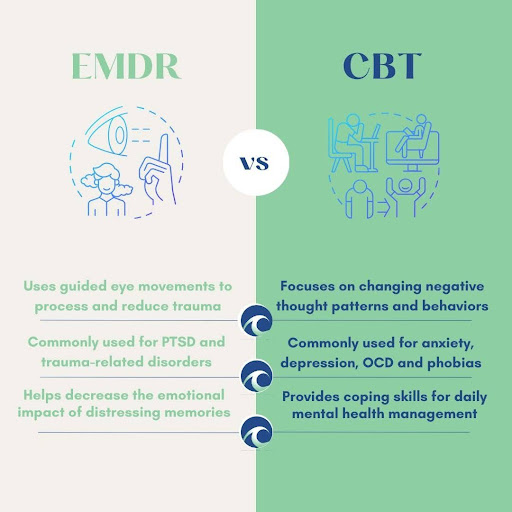EMDR vs CBT: Understanding the Differences in Trauma Treatment Techniques
EMDR vs CBT: Which is Best? EMDR and CBT are two well-known therapies used to treat various mental health issues. When comparing EMDR, which focuses on eye movement desensitization and reprocessing, to CBT, which addresses thought patterns and behaviors, it’s clear that each has its strengths in different situations. EMDR is particularly effective for trauma, while CBT is widely used for anxiety and depression.
EMDR helps individuals process traumatic experiences by using bilateral stimulation, often through directed eye movements. This therapy aims to reduce the intensity of distressing memories and emotions. On the other hand, CBT focuses on identifying and changing negative thought patterns, making it a practical approach for everyday mental health struggles.
Understanding these differences can guide individuals in choosing the right therapy for their needs. Whether someone is looking to cope with trauma or change harmful thoughts, recognizing the benefits of each method is crucial for effective treatment.
Understanding EMDR vs CBT
EMDR and CBT are two different types of therapies used in psychotherapy. Each has its own methods and ideas about how to help people with mental health issues, especially trauma and anxiety.
Foundational Concepts of EMDR
EMDR, or Eye Movement Desensitization and Reprocessing, is a therapy designed to treat trauma. It was developed by Francine Shapiro in the late 1980s. The key idea is that bilateral stimulation, which often involves following moving lights or sounds, helps the brain process distressing memories.
During EMDR, clients focus on traumatic memories while the therapist guides them through specific eye movements. This process aims to reduce the emotional charge of the memory. As clients revisit these memories, they can begin to integrate them into their lives more fluidly. EMDR has gained recognition and is widely used for treating PTSD and other trauma-related conditions.
Learn more about Eye Movement Desensitization and Reprocessing here
Core Principles of CBT
Cognitive Behavioral Therapy (CBT) focuses on identifying and changing negative thought patterns. It is based on the idea that thoughts, feelings, and behaviors are connected. By modifying harmful thoughts, individuals can improve their emotional state and actions.
CBT often includes techniques like cognitive restructuring. This helps clients challenge irrational beliefs and replace them with more positive ones. Therapists work with clients to set goals and develop coping strategies. Unlike EMDR, CBT is structured and usually involves homework assignments to practice skills. This practical approach helps individuals apply what they learn in real-life situations.
Learn more about Cognitive Behavioral Therapy here

Comparative Analysis of EMDR and CBT
EMDR and CBT are two distinct therapeutic methods. They target various mental health issues using different techniques.
Differences in Therapeutic Approaches: EMDR vs CBT
EMDR, or Eye Movement Desensitization and Reprocessing, focuses on processing traumatic memories. It uses guided eye movements to help clients reprocess these memories. This approach often helps with PTSD and anxiety related to traumatic events.
On the other hand, CBT, or Cognitive Behavioral Therapy, centers on changing negative thought patterns. It aims to help clients identify and challenge unhelpful beliefs. CBT is effective for anxiety, depression, OCD, and phobias.
Both therapies create tailored treatment plans. They involve different techniques but share the goal of improving mental health.
Efficiency and Application in Disorders
EMDR is particularly useful for individuals with PTSD. Studies show it can significantly reduce symptoms in a shorter time. It also addresses specific traumatic memories rather than broader thought patterns.
CBT, meanwhile, is widely recognized for treating anxiety, depression, and OCD. It helps people develop coping strategies and skills to manage their conditions. It is generally a longer process but is effective for various psychological disorders.
Both therapies can be useful in different situations. Choosing between them often depends on the specific issues faced by the individual. The best choice may vary based on personal preferences and treatment goals.
Treatment and Efficacy
Both EMDR and CBT are effective forms of therapy used to treat various mental health conditions. They have different methods and targets, making them suitable for particular issues.
EMDR in Treating Trauma and PTSD
Eye Movement Desensitization and Reprocessing (EMDR) is especially helpful for those with trauma-related conditions, such as post-traumatic stress disorder (PTSD). This therapy focuses on processing distressing memories.
During EMDR, a therapist guides the patient through specific eye movements while recalling traumatic events. This technique can reduce the intensity of emotional distress linked to those memories. Research shows that EMDR is effective in decreasing symptoms of PTSD for many individuals.
In clinical trials, EMDR has been compared to traditional treatments and has shown similar or better results. Patients often find relief and begin to heal more quickly than with some other therapies.
CBT for Anxiety and Depression
Cognitive Behavioral Therapy (CBT) is widely used for anxiety disorders and depression. The focus here is on changing negative thought patterns and behaviors. CBT teaches patients skills to cope with their feelings and reactions.
In sessions, therapists help clients identify unhelpful thoughts. Then, they work on developing strategies to turn those thoughts into positive ones. Studies have found CBT to be effective in improving mood and reducing anxiety symptoms.
For individuals facing anxiety or depression, CBT has solid evidence supporting its use. Many people experience significant improvement within a few months of treatment. It equips them with tools that promote long-term mental health.
Considerations for Mental Health Care: EMDR vs CBT
Choosing the right therapy for mental health is crucial. EMDR and CBT both have unique benefits and considerations. Understanding these can help individuals make informed choices for their mental well-being.
Choosing Between EMDR and CBT
When selecting between EMDR and CBT, individuals should consider their specific needs. EMDR is often effective for trauma survivors. It focuses on processing distress from traumatic memories. This method can lead to significant benefits for those with PTSD or related disorders.
CBT, on the other hand, is structured and helps in developing coping strategies. It addresses negative thought patterns and behaviors. This approach is beneficial for those with anxiety, depression, or substance abuse issues.
Clients may consult with mental health professionals to determine which therapy aligns with their personal growth goals and coping skills. Tailoring the therapy to the individual’s unique situation enhances effectiveness.
Integrating Therapies for Comprehensive Care
Combining EMDR and CBT can provide comprehensive mental health care. Each method can complement the other. For instance, CBT can help build coping skills before engaging in the deeper work of EMDR. Combining different forms of therapy are the cornerstone of a mental health intensive outpatient program.
This integration allows for addressing both current issues and underlying trauma. Mental health treatment often benefits from such a holistic approach. It can be especially useful for clients dealing with multiple mental disorders or addiction.
Clients should discuss integration plans with their therapists. This ensures the approach is tailored to their personal needs and enhances their journey towards better mental well-being.




